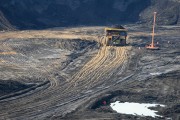Given that oilsands products aren't currently shipped to Europe in significant quantities, you may be puzzled by all the hoo-ha about the Europeans' clean fuel law.
Let us explain. The European Union's fuel quality directive requires oil companies to reduce greenhouse gas emissions by six per cent by 2020, compared to 2010 levels. To implement this law, the European Commission is in the process of setting carbon values for various fuels — including oilsands. At first, oilsands was set at 107 grams per megajoule, compared to conventional oil at around 86 grams per megajoule (about 23 per cent more greenhouse gas intensive), but Canada made several objections and succeeded in making the oilsands value disappear — temporarily.
Why are Canadian politicians aggressively lobbying to derail a European fuel directive if there are no significant plans to export oilsands crude to Europe? The truth is, Canadian and Albertan officials are fighting tooth and nail to prevent oilsands being officially classified as a high-carbon fuel anywhere — the reason being that if a major body such as the European Union does so, it'll be much harder for Canadian officials to continue claiming the oilsands are an environmentally responsible source of oil. Of course, they're also afraid other jurisdictions will follow Europe's lead.
Despite the Canadian government's lobbying efforts, the European Commission has committed to assigning a new value to oilsands in 2011 and as such commissioned an independent, peer reviewed analysis by Stanford University's department of energy resources engineering, which was released last week.
Stanford professor and life cycle analysis expert Adam Brandt based his report on six previous studies and concludes that upstream emissions (extraction and upgrading) are more than five times greater for oilsands than the European Union average for conventional oil.
 The report finds that lifecycle emissions (sometimes referred to as wells to wheels) are on average 23 per cent higher for oilsands, compared to European Union average conventional oil.
The report finds that lifecycle emissions (sometimes referred to as wells to wheels) are on average 23 per cent higher for oilsands, compared to European Union average conventional oil.
Further, the report also omitted the Cambridge Energy Research Associates (CERA) study (that the oil industry and the Canadian and Albertan governments like to quote from), because the methodology was not transparently described. The CERA report pegged oilsands lifecycle emissions at just five to 15 per cent more carbon intensive than conventional oil, but several issues have been raised about their analysis.
Not surprisingly, Alberta Energy Minister Ron Liepert is challenging the Stanford study and will no doubt be raising his concerns before the European Commission. It will be important for the European Commission to recognize that there is already significant variation in the estimates made of greenhouse gas emissions from oilsands and part of that variation is due to what is actually being measured.
In a recent publication, Pembina outlined the factors that caused this wide variation so decision-makers are clear on how to approach decisions before them. Ideally, studies are comprehensive and consider all of the different emissions that come from the production of oilsands. Unlike the CERA report, the Stanford University report prepared for the European Commission closely follows our recommendations to fully document what is being measured, and how, in a transparent manner.
After Brandt evaluated all of the studies, he concluded that greenhouse gas emissions from oilsands production are "significantly different enough from conventional oil emissions that regulatory frameworks should address this discrepancy."
This latest report serves to solidify the fact there is no valid debate about whether or not the oilsands are significantly more greenhouse gas intensive than conventional oil sources — there is a spin campaign by government and industry and then there's the truth. It's well past time for government and industry to take the steps to achieve significant reductions in the greenhouse gas intensity of oilsands production.









